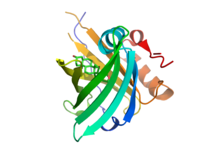Anticalin

Anticalin proteins are artificial
The Anticalin technology is exclusively commercialized by Pieris Pharmaceuticals in Freising, Germany.[1] Anticalin is a registered trademark of Pieris.[citation needed]
Properties
Anticalin proteins have better tissue penetration than antibodies and are stable at temperatures up to 70 °C. Unlike antibodies, they can be produced in bacterial cells like
While antibodies can only be directed at macromolecules such as proteins and at small molecules (haptens) only if bound to macromolecules,[3] Anticalin proteins are able to selectively bind to small molecules as well.[citation needed]
They were mainly developed at the
Structure
Characteristic for Anticalin proteins is their barrel structure formed by eight antiparallel
References
- ^ "Pieris Pharmaceuticals, Inc". Pieris Pharmaceuticals, Inc. Retrieved 16 June 2015.
- ^ S2CID 19992238.
- ISBN 3-8047-1763-2.
- ^ Skerra, A (2002). "Anticaline" (PDF). BIOforum (in German). 4/2002. Darmstadt: GIT Verlag: 227–229.[permanent dead link]
- ^ "Deutscher Zukunftspreis 2004: Anticaline – Biopharmazeutische Wirkstoffe durch Protein-Design" [German Future Prize 2004: Anticalins – Biopharmaceutical agents by protein design] (in German). Stifterverband für die Deutsche Wissenschaft. Archived from the original on 8 December 2010. Retrieved 6 December 2010.

